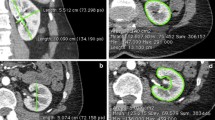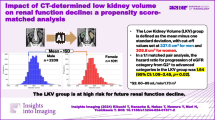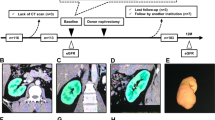Abstract
Objectives
The goal of this study was to retrospectively investigate the relationship between renal transplanted volume indexes (Total kidney volume (TKV)/Body surface area (BSA), Renal parenchymal volume (RPV)/BSA, Renal cortical volume (RCV)/BSA, RPV/Body mass index (BMI), RCV/BMI, RPV/Weight, RCV/Weight), and short- and long-term function of the graft.
Methods
One-hundred and twelve live donor-recipient pairs from 2017 to 2018, whose donors underwent preoperative renal computed tomography angiography and recipients survived during 12 months of follow-up, were included in this study.
Results
The crude and adjusted linear regressions for the effect of volume measurements by voxel and ellipsoid methods on the estimated glomerular filtration rate (eGFR) at different post-transplantation times demonstrated that the RPV/weight ratio had the most substantial crude effect on the eGFR 12 months and 4 years after renal transplant. Receiver operating characteristic (ROC) curves for six different renal volume ratios demonstrated no significant difference between these ratios in terms of discriminative ability (p value < 0.05). A strong direct correlation between TKV calculated by the ellipsoid formula with RPV and RCV measured using OsiriX software was noted. Analysis of ROC curves for renal volume indices has demonstrated fair to good discriminative ability of our cut-off points to estimate 4-year post-transplantation eGFR > 60 mL/min.
Conclusion
Renal transplant recipients’ volume indices, such as RPV/weight, had strong correlations with eGFR at different points in time, and renal transplant recipients with the volume ratios higher than our cut-off points had a good chance of having a 4-year post-transplantation eGFR higher than 60 mL/min.


Similar content being viewed by others
Change history
28 December 2023
A Correction to this paper has been published: https://doi.org/10.1007/s00261-023-04155-x
Abbreviations
- BMI:
-
Body mass index
- TKV:
-
Total kidney volume
- BSA:
-
Body surface area
- RPV:
-
Renal parenchymal volume
- RCV:
-
Renal cortical volume
- eGFR:
-
Estimated glomerular filtration rate
- ESRD:
-
End-stage renal disease
- RTRs:
-
Renal transplant recipients
- MDRD:
-
Modification of diet in renal disease
- KDIGO:
-
Kidney disease: improving global outcomes
References
Dias J, Malheiro J, Almeida M, Dias L, Silva-Ramos M, Martins LS, Xambre L, Castro-Henriques A: CT-based renal volume and graft function after living-donor kidney transplantation: Is there a volume threshold to avoid? Int Urol Nephrol 2015, 47:851-859.
Lentine KL, Pastan S, Mohan S, Reese PP, Leichtman A, Delmonico FL, Danovitch GM, Larsen CP, Harshman L, Wiseman A, et al: A Roadmap for Innovation to Advance Transplant Access and Outcomes: A Position Statement From the National Kidney Foundation. American Journal of Kidney Diseases 2021, 78:319-332.
Wang HH, Lin KJ, Liu KL, Chu SH, Hsieh CY, Chiang YJ: Size does matter-donor-to-recipient body mass index difference may affect renal graft outcome. Transplant Proc 2012, 44:267-269.
Lee JH, Won JH, Oh CK: Impact of the ratio of graft kidney volume to recipient body surface area on graft function after live donor kidney transplantation. Clin Transplant 2011, 25:E647-655.
Hugen CM, Polcari AJ, Farooq AV, Fitzgerald MP, Holt DR, Milner JE: Size does matter: donor renal volume predicts recipient function following live donor renal transplantation. J Urol 2011, 185:605-609.
Chandar J, Chen L, Defreitas M, Ciancio G, Burke G: Donor considerations in pediatric kidney transplantation. Pediatric Nephrology 2021, 36:245-257.
Ebad CA, Brennan D, Chevarria J, Hussein MB, Sexton D, Mulholland D, Doyle C, O'Kelly P, Williams Y, Dunne R, et al: Is Bigger Better? Living Donor Kidney Volume as Measured by the Donor CT Angiogram in Predicting Donor and Recipient eGFR after Living Donor Kidney Transplantation. J Transplant 2021, 2021:8885354-8885354.
Silva F, Malheiro J, Pestana N, Ribeiro C, Nunes-Carneiro D, Mandanelo M, Tavares J, Pedroso S, Almeida M, Silva-Ramos M, et al: Lower donated kidney volume is associated with increased risk of lower graft function and acute rejection at 1 year after living donor kidney-a retrospective study. Transpl Int 2020, 33:1711-1722.
Qiu Y, Liu J, Jiang Y, Song T, Huang Z, Fan Y, Wang X, Lin T: Effect of donor kidney morphology parameters on the prognosis in living kidney transplantation recipients. Transl Androl Urol 2020, 9:1957-1966.
Janoff DM, Davol P, Hazzard J, Lemmers MJ, Paduch DA, Barry JM: Computerized tomography with 3-dimensional reconstruction for the evaluation of renal size and arterial anatomy in the living kidney donor. J Urol 2004, 171:27-30.
Tsushima Y, Blomley MJ, Kusano S, Endo K: Use of contrast-enhanced computed tomography to measure clearance per unit renal volume: a novel measurement of renal function and fractional vascular volume. Am J Kidney Dis 1999, 33:754-760.
Sommer G, Bouley D, Frisoli J, Pierce L, Sandner-Porkristl D, Fahrig R: Determination of 3-dimensional zonal renal volumes using contrast-enhanced computed tomography. J Comput Assist Tomogr 2007, 31:209-213.
Muto NS, Kamishima T, Harris AA, Kato F, Onodera Y, Terae S, Shirato H: Renal cortical volume measured using automatic contouring software for computed tomography and its relationship with BMI, age and renal function. European Journal of Radiology 2011, 78:151-156.
Aghayev A, Gupta S, Dabiri BE, Steigner ML: Vascular imaging in renal donors. Cardiovasc Diagn Ther 2019, 9:S116-s130.
Terasaki PI, Koyama H, Cecka JM, Gjertson DW: The hyperfiltration hypothesis in human renal transplantation. Transplantation 1994, 57:1450-1454.
Sakai T, Billo R, Kriz W: The structural organization of the kidney of Typhlonectes compressicaudus (Amphibia, Gymnophiona). Anat Embryol (Berl) 1986, 174:243-252.
Levey AS, Eckardt KU, Tsukamoto Y, Levin A, Coresh J, Rossert J, De Zeeuw D, Hostetter TH, Lameire N, Eknoyan G: Definition and classification of chronic kidney disease: a position statement from Kidney Disease: Improving Global Outcomes (KDIGO). Kidney Int 2005, 67:2089-2100.
Kukla A, Adulla M, Pascual J, Samaniego M, Nanovic L, Becker BN, Djamali A: CKD stage-to-stage progression in native and transplant kidney disease. Nephrol Dial Transplant 2008, 23:693-700.
Djamali A, Kendziorski C, Brazy PC, Becker BN: Disease progression and outcomes in chronic kidney disease and renal transplantation. Kidney International 2003, 64:1800-1807.
Wan SS, Cantarovich M, Mucsi I, Baran D, Paraskevas S, Tchervenkov J: Early renal function recovery and long-term graft survival in kidney transplantation. Transpl Int 2016, 29:619-626.
Smith-Palmer J, Kalsekar A, Valentine W: Influence of renal function on long-term graft survival and patient survival in renal transplant recipients. Current Medical Research and Opinion 2014, 30:235-242.
Correction to: Lenihan, et al., MDRD-Estimated GFR at One Year Post-Renal Transplant is a Predictor of Long-Term Graft Function. Ren Fail 2018, 40:119–119.
First MR: Renal function as a predictor of long‐term graft survival in renal transplant patients. Nephrology Dialysis Transplantation 2003, 18:i3-i6.
Hariharan S, McBride MA, Cherikh WS, Tolleris CB, Bresnahan BA, Johnson CP: Post-transplant renal function in the first year predicts long-term kidney transplant survival. Kidney Int 2002, 62:311-318.
Shimoyama H, Isotani S, China T, Nagata M, Yokota I, Kitamura K, Wakumoto Y, Ide H, Muto S, Tujimura A, et al: Automated renal cortical volume measurement for assessment of renal function in patients undergoing radical nephrectomy. Clin Exp Nephrol 2017, 21:1124-1130.
Han SS, Yang SH, Oh YJ, Cho JY, Moon KC, Ha J, Kim YS: Graft volume as the surrogate marker for nephron number affects the outcomes of living-donor kidney transplantation. Clin Transplant 2011, 25:E327-335.
Nair S, Mishra V, Hayden K, Lisboa PJG, Pandya B, Vinjamuri S, Hardy KJ, Wilding JPH: The four-variable modification of diet in renal disease formula underestimates glomerular filtration rate in obese type 2 diabetic individuals with chronic kidney disease. Diabetologia 2011, 54:1304-1307.
Levey AS, Bosch JP, Lewis JB, Greene T, Rogers N, Roth D: A more accurate method to estimate glomerular filtration rate from serum creatinine: a new prediction equation. Modification of Diet in Renal Disease Study Group. Ann Intern Med 1999, 130:461–470.
Orimadegun A, Omisanjo A: Evaluation of five formulae for estimating body surface area of nigerian children. Ann Med Health Sci Res 2014, 4:889-898.
Lenihan CR, O'Kelly P, Mohan P, Little D, Walshe JJ, Kieran NE, Conlon PJ: MDRD-estimated GFR at one year post-renal transplant is a predictor of long-term graft function. Ren Fail 2008, 30:345-352.
Marcén R, Pascual J, Tenorio M, Ocaña EJ, Teruel JL, Villafruela JJ, Fernández M, Burgos FJ, Ortuño J: Chronic kidney disease in renal transplant recipients. Transplant Proc 2005, 37:3718-3720.
Maldonado G, Greenland S: Simulation study of confounder-selection strategies. Am J Epidemiol 1993, 138:923-936.
Dormann CF, Elith J, Bacher S, Buchmann C, Carl G, Carré G, Marquéz JRG, Gruber B, Lafourcade B, Leitão PJ, et al: Collinearity: a review of methods to deal with it and a simulation study evaluating their performance. Ecography 2013, 36:27-46.
Sikora MB, Shaaban A, Beddhu S, Bourija H, Wei G, Baird B, Truax CM, Shihab FS: Effect of donor kidney volume on recipient outcome: does the "dose" matter? Transplantation 2012, 94:1124-1130.
Poggio ED, Hila S, Stephany B, Fatica R, Krishnamurthi V, del Bosque C, Goldfarb D, Herts B, Dennis VW, Heeger PS, Braun W: Donor kidney volume and outcomes following live donor kidney transplantation. Am J Transplant 2006, 6:616-624.
Saxena AB, Busque S, Arjane P, Myers BD, Tan JC: Preoperative renal volumes as a predictor of graft function in living donor transplantation. Am J Kidney Dis 2004, 44:877-885.
Breau RH, Clark E, Bruner B, Cervini P, Atwell T, Knoll G, Leibovich BC: A simple method to estimate renal volume from computed tomography. Can Urol Assoc J 2013, 7:189-192.
Lal H, Singh A, Prasad R, Yadav P, Akhtar J, Barai S, Mishra P, Bhadauria D, Kaul A, Prasad N, Verma P: Determination of split renal function in voluntary renal donors by multidetector computed tomography and nuclear renography: How well do they correlate? SA Journal of Radiology 2021, 25:1-8.
Funding
The authors state that this work has not received any funding.
Author information
Authors and Affiliations
Corresponding author
Additional information
Publisher's Note
Springer Nature remains neutral with regard to jurisdictional claims in published maps and institutional affiliations.
The original online version of this article was revised:The original version of this article contained an error in one of the co-author's family name. The co- author name should read as ``Tania Dehesh'' instead of “Tania Dahesh”.
Rights and permissions
Springer Nature or its licensor (e.g. a society or other partner) holds exclusive rights to this article under a publishing agreement with the author(s) or other rightsholder(s); author self-archiving of the accepted manuscript version of this article is solely governed by the terms of such publishing agreement and applicable law.
About this article
Cite this article
Mahdavi, A., Negarestani, A.M., Masoumi, N. et al. Studying the effect of donor kidney volume ratios to recipients’ body surface area, body mass index, and total body weight on post-transplant graft function. Abdom Radiol 48, 2361–2369 (2023). https://doi.org/10.1007/s00261-023-03921-1
Received:
Revised:
Accepted:
Published:
Issue Date:
DOI: https://doi.org/10.1007/s00261-023-03921-1




